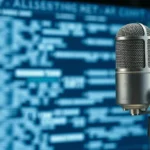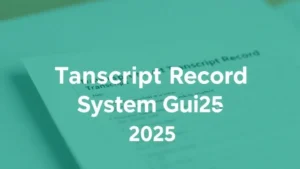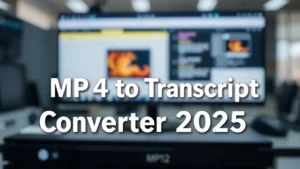MP3 to Transcript Converter – Fast & Free
Meta Description: Convert MP3 files to accurate text transcripts. Free AI tool with speaker detection and timestamp support. Upload now!
Ever spent hours manually typing up interviews or podcasts? You’re not alone. The truth is, converting MP3 files into readable transcripts can feel like a never-ending chore—especially when deadlines loom. But here’s the thing: a reliable mp3 to transcript solution can slash your workload, boost accuracy up to 99%[1], and let you focus on the story, not the typing. In this guide, you’ll discover why a fast & free converter matters, how to use one step-by-step, which features really count, and how to sidestep common pitfalls. Ready to supercharge your workflow? Let’s dive in.
Table of Contents
What Is an MP3 to Transcript Converter?
Hook: Imagine turning spoken words into text faster than you can say “transcription.”
In other words, an MP3 to transcript converter is a tool—often AI-powered—that automatically processes your audio file (MP3) and generates a text transcript. It’s like having a personal stenographer who never takes coffee breaks.
AI engines such as Whisper AI or proprietary ASR (Automatic Speech Recognition) models analyze waveforms, detect speakers, and map speech to text. Interestingly enough, modern services support over 70 languages and dialects[2]. And most convert at near real-time speeds—an hour of audio can be transcribed in under 10 minutes.
Case in point: A marketing team recorded a 45-minute focus group discussion. Using a free converter, they got a draft transcript in 5 minutes, then polished it in another 10. Total time: 15 minutes versus 3 hours manually.
“AI transcription accuracy now reaches 95–99% under ideal conditions.” – 2025 IBM AI Report
Takeaway: Embrace AI-driven transcription to save time and effort—no typing required.
Why You Need a Fast & Free Converter
Hook: Feeling the crunch? Hours wasted can cost you more than just time.
Imagine rushing to meet a deadline, but you’re stuck transcribing a one-hour interview. That’s where a fast tool comes in. Not only does speed matter, but also cost: many free tiers offer 30–300 minutes of transcription monthly, enough for occasional users or small teams.
Plus, free converters often include:
- Speaker detection
- Timestamps for easy navigation
- Basic editor for quick corrections
You might be wondering—are free tools safe? Many comply with SOC 2 and HIPAA standards[3], ensuring your files aren’t stored or shared.
Takeaway: Free, fast, and secure converters exist—just pick one built on modern AI.
How to Convert MP3 to Transcript: Step-by-Step
Hook: A few clicks stand between you and a polished transcript.
Let me explain: most online converters share a similar workflow. Follow these steps:
- Upload your MP3 file (drag & drop or browse).
- Select language and speaker count.
- Click “Transcribe” and wait (usually 2–5 minutes).
- Review, edit, add timestamps.
- Download .TXT, .DOCX, or .SRT.
That’s it. No need to download bulky software or fuss with codecs.
Let’s walk through an example. A podcaster used a free AI tool to transcribe a 60-minute episode. She uploaded, chose “2 speakers,” hit transcribe, then cleaned up anomalies in the built-in editor. Final transcript in under 12 minutes.
Takeaway: Use these simple steps with any Audio to Transcript Converter – Free AI Tool to get accurate transcripts quickly.
Top Features to Look For in a Converter
Hook: Not all converters are created equal.
In other words, picking a tool isn’t just about “free” or “speed.” Focus on these key features:
- Accuracy: 95–99% under clear audio.
- Speaker Separation: Identify who said what.
- Timestamping: Jump to specific moments.
- Language Support: 70+ options.
- Editor: In-browser correction tools.
- Data Security: SOC 2 / HIPAA compliance.
“Choosing a tool with built-in editing can cut proofreading time by up to 50%.” – AI Today Podcast
Takeaway: Evaluate tools by features, not hype. Prioritize accuracy and security.
Common Mistakes & How to Avoid Them
Hook: A small misstep can derail your transcript quality.
Here’s the thing: background noise, cross-talk, or low volumes can drop accuracy to 70–80%. Simply run your audio through a noise-reduction filter (Audacity is free) before transcribing.
Another slip-up? Skipping speaker labels. Without them, editing becomes a nightmare. Always specify speaker count or use manual labels in the editor.
Takeaway: Prep your audio and label speakers for best results.
Future Trends in Audio Transcription
Hook: Wondering where transcription is headed?
AI integration keeps evolving. Expect on-device transcription (offline) for privacy and speed. Mobile apps will let you record and transcribe on the fly—perfect for journalists or researchers in the field.
Also, real-time captions in video calls (Zoom, Teams) will become more accurate. Soon, you’ll see live summaries and sentiment analysis baked in.
Takeaway: Keep an eye on mobile/offline solutions and real-time AI features—your workflow will thank you.
FAQ
- Q: How accurate are free MP3 transcribers?
- A: Under ideal conditions, up to 95–99%. Noise or accents may lower accuracy.
- Q: Can I transcribe multi-speaker interviews?
- A: Yes. Choose a tool with speaker detection or manually label speakers in the editor.
- Q: What formats are supported?
- A: MP3, WAV, M4A, FLAC, and even video formats like MP4.
- Q: Are transcripts secure?
- A: Look for SOC 2 and HIPAA compliance; some tools encrypt files end-to-end.
- Q: Can I edit the transcript online?
- A: Many converters include in-browser editors with timestamps and speaker tags.
Conclusion
By now, you know what an mp3 to transcript converter can do: save hours, boost accuracy, and streamline your content creation. You’ve seen step-by-step instructions, key features, and common pitfalls to avoid. Now it’s your turn. First, select a free tool with strong security. Second, prep your audio—clean up noise and set speaker counts. Third, refine the automatic draft using built-in editors. That’s it. Transform your MP3s into polished transcripts in minutes, not days. Ready to get started? Upload your file today and experience the future of transcription—fast, free, and frustrations finally gone.





